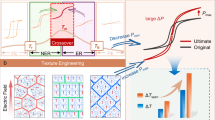Abstract
THE thermal expansion method for determining firing temperatures1–3 is based on the assumption that, when clays are fired, shrinkage occurs as a result of various sintering processes such as vitrification. Consequently when a clay ceramic is heated up from room temperature (see Fig. 1) it typically exhibits a reversible expansion, characteristic of its mineralogical composition, until temperatures comparable with the original firing temperature are reached. With continued increase in temperature the ceramic begins to contract because superimposed on the reversible expansion there is an irreversible shrinkage associated with resumption of sintering (that is, the firing of the ceramic is being continued beyond the point reached during the original firing). The temperature (Ta) at which a net shrinkage is first observed should therefore provide an indication of the original firing temperature (Te) of the ceramic.
This is a preview of subscription content, access via your institution
Access options
Subscribe to this journal
Receive 51 print issues and online access
$199.00 per year
only $3.90 per issue
Buy this article
- Purchase on SpringerLink
- Instant access to full article PDF
Prices may be subject to local taxes which are calculated during checkout
Similar content being viewed by others
References
Kiefer, Ch., Bull. Soc. Franc. Ceram., 30, 3 (1956); 31, 17 (1956).
Terrisse, J. R., Rei Cretariae Romanae Fautorum, 2, 63 (1959).
Roberts, J. P., Archaeometry, 6, 21 (1963).
Baudran, A., Bull. Soc. Franc. Ceram., 27, 13 (1955).
Perinet, G., Trans. Seventh Intern. Ceram. Cong., London, 371 (1960).
Author information
Authors and Affiliations
Rights and permissions
About this article
Cite this article
TITE, M. Determination of the Firing Temperature of Ancient Ceramics by Measurement of Thermal Expansion. Nature 222, 81 (1969). https://doi.org/10.1038/222081a0
Received:
Issue date:
DOI: https://doi.org/10.1038/222081a0
This article is cited by
-
Research on the degradation of ancient Longquan celadons in the Dalian Island shipwreck
npj Materials Degradation (2022)
-
Corrosion of Longquan celadons in the marine environment: study on the celadons from the Dalian Island shipwreck of the Yuan Dynasty
Heritage Science (2021)
-
Study on firing temperature of the Song Dynasty (960–1279AD) greenish-white porcelain in Guangxi, China by thermal expansion method
Heritage Science (2019)
-
Examination of ancient pottery using the scanning electron microscope
Nature (1975)



